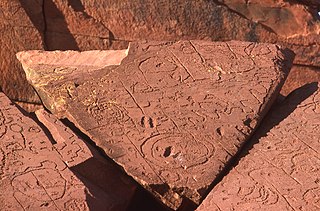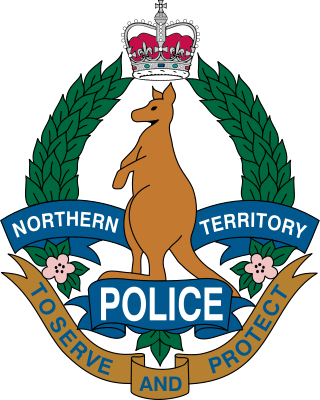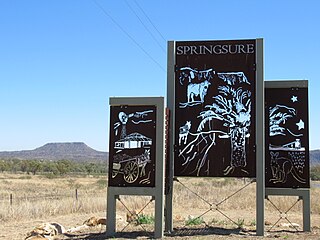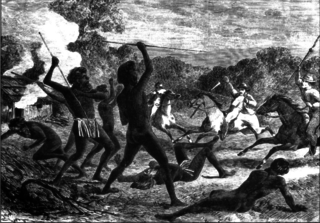Related Research Articles

The protected areas of the Northern Territory consists of protected areas managed by the governments of the Northern Territory and Australia and private organisations with a reported total area of 335,527 square kilometres (129,548 sq mi) being 24.8% of the total area of the Northern Territory of Australia.
Gija, also spelt Gidja and Kija, alternatively known as the Lungga, refers to Aboriginal Australians from the East Kimberley area of Western Australia, about 200 km south of Kununurra. In the late 19th century pastoralists were fiercely resisted by Gija people, many of whom now live around localities such as Halls Creek and Warmun.

Arnhem Land is a historical region of the Northern Territory of Australia, with the term still in use. It is located in the north-eastern corner of the territory and is around 500 km (310 mi) from the territory capital, Darwin. In 1623, Dutch East India Company captain Willem Joosten van Colster sailed into the Gulf of Carpentaria and Cape Arnhem is named after his ship, the Arnhem, which itself was named after the city of Arnhem in the Netherlands.

Inverell is a large town in northern New South Wales, Australia, situated on the Macintyre River, close to the Queensland border. It is also the centre of Inverell Shire. Inverell is located on the Gwydir Highway on the western slopes of the Northern Tablelands. It has a temperate climate. In the 2021 census, the population of Inverell was 12,057 and the Inverell Shire population was 17,853.

The Northern Territory Police Force is the police body that has legal jurisdiction over the Northern Territory of Australia. This police service has 1,537 police members made up of 79 senior sergeants, 228 sergeants, 839 constables, 208 auxiliaries, and 73 Aboriginal Community Police Officers. The rest of the positions are members of commissioned rank and inoperative positions. It also has a civilian staff working across the NT Police, Fire and Emergency Services.

Springsure is a town and a locality in the Central Highlands Region, Queensland, Australia. It is 66 kilometres (41 mi) south of Emerald on the Gregory Highway. It is the southern terminus of the Gregory Highway and the northern terminus of the Dawson Highway. It is 765 kilometres (475 mi) northwest of Brisbane. At the 2021 census, Springsure had a population of 950 people.
The Myall Creek massacre was the killing of at least twenty-eight unarmed Indigenous Australians by twelve colonists on 10 June 1838 at the Myall Creek near the Gwydir River, in northern New South Wales. After two trials, seven of the twelve colonists were found guilty of murder and hanged, a verdict which sparked extreme controversy within New South Wales settler society. One—the leader and free settler John Fleming—evaded arrest and was never tried. Four were never retried following the not guilty verdict of the first trial.
Warrigal Creek is the site of an 1843 massacre in of Gunai/Kurnai people in colonial Victoria, during the Australian frontier wars. The creek is on a farm 40 kilometres (25 mi) south of Sale, and 200 kilometres (120 mi) east of Melbourne, in the South Gippsland area of Victoria, Australia.

Quirindi is a small town on the North West Slopes region of New South Wales, Australia, in Liverpool Plains Shire. At the 2016 census, Quirindi had a population of 3,444. It is the nearest link to Gunnedah to the west and Tamworth to the north. The local economy is based on agriculture, with broadacre farming dominant on the black soil plains to the west and livestock grazing in the hilly eastern part of the district.

The Fitzroy River is located in the West Kimberley region of Western Australia. It has 20 tributaries and its catchment occupies an area of 93,829 square kilometres (36,228 sq mi), within the Canning Basin and the Timor Sea drainage division.
The Gippsland massacres were a series of mass murders of Gunai Kurnai people, an Aboriginal Australian people living in East Gippsland, Victoria, committed by European settlers and the Aboriginal Police during the Australian frontier wars.
{[Short description|Massacre of Indigenous Australians by law enforcement}}
The Blood Hole massacre occurred in what is now the Australian state of Victoria at Middle Creek, 10–11 kilometres (6–7 mi) from Glengower Station between Clunes and Newstead at the end of 1839 or early 1840, killing an unknown number of Aboriginals from the Grampians district who were on their way home after trading goods for green stone axe blanks that they obtained near what is now Lancefield.

The Australian frontier wars were the violent conflicts between Indigenous Australians and non-Indigenous settlers during the colonisation of Australia. The first conflict took place several months after the landing of the First Fleet in January 1788, and the last frontier conflicts occurred into the early 20th century, with some occurring as late as 1934. An estimated minimum of 100,000 Indigenous Australians and between 2,000 and 2,500 settlers died in the conflicts. Conflicts occurred in a number of locations across Australia.

Wave Hill Station, most commonly referred to as Wave Hill, is a pastoral lease in the Northern Territory operating as a cattle station. The property is best known as the scene of the Wave Hill walk-off, a strike by Indigenous Australian workers for better pay and conditions, which in turn was an important influence on Aboriginal land rights in Australia.
Bedford Downs, or Bedford Downs Station, is a pastoral lease that operates as a cattle station in Western Australia.

Myall Creek Massacre and Memorial Site is the heritage-listed site of and memorial for the victims of the Myall Creek massacre at Bingara Delungra Road, Myall Creek, Gwydir Shire, New South Wales, Australia. The memorial, which was unveiled in 2000, was added to the Australian National Heritage List on 7 June 2008 and the New South Wales State Heritage Register on 12 November 2010.
Myall Creek is a locality split between the local government areas of Inverell Shire and the Gwydir Shire in New South Wales, Australia. In the 2016 census, Myall Creek had a population of 38 people.
References
- 1 2 Davis, Therese; Moreton, Romaine (2013). "Indigenous Performance of History, Loss and Remembrance Inwhispering in Our Hearts". Interventions. 15 (2): 211–223. doi:10.1080/1369801x.2013.798472. ISSN 1369-801X. S2CID 161599168.
- ↑ "Australian Web Archive". Archived from the original on 2 September 2011.
- ↑ "Mowla Bluff Massacre". Monument Australia. Retrieved 14 April 2019.